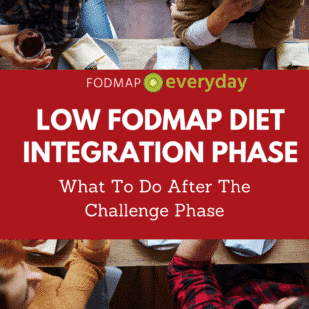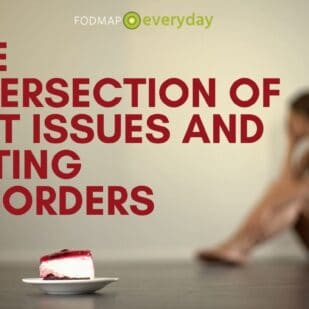The low FODMAP diet has three phases; the first Elimination Phase will take an average of 4 weeks.
The second Challenge Phase can take longer, even up to 8 weeks. Eventually you reach the Integration Phase, which is longer term, and sometimes referred to as the “modified low FODMAP diet”. Ideally these Phases are conducted straight through, but what about pausing the low FODMAP diet?
Can you start, stop and start again during these Phases? This article will address this question: can you pause the low FODMAP diet?
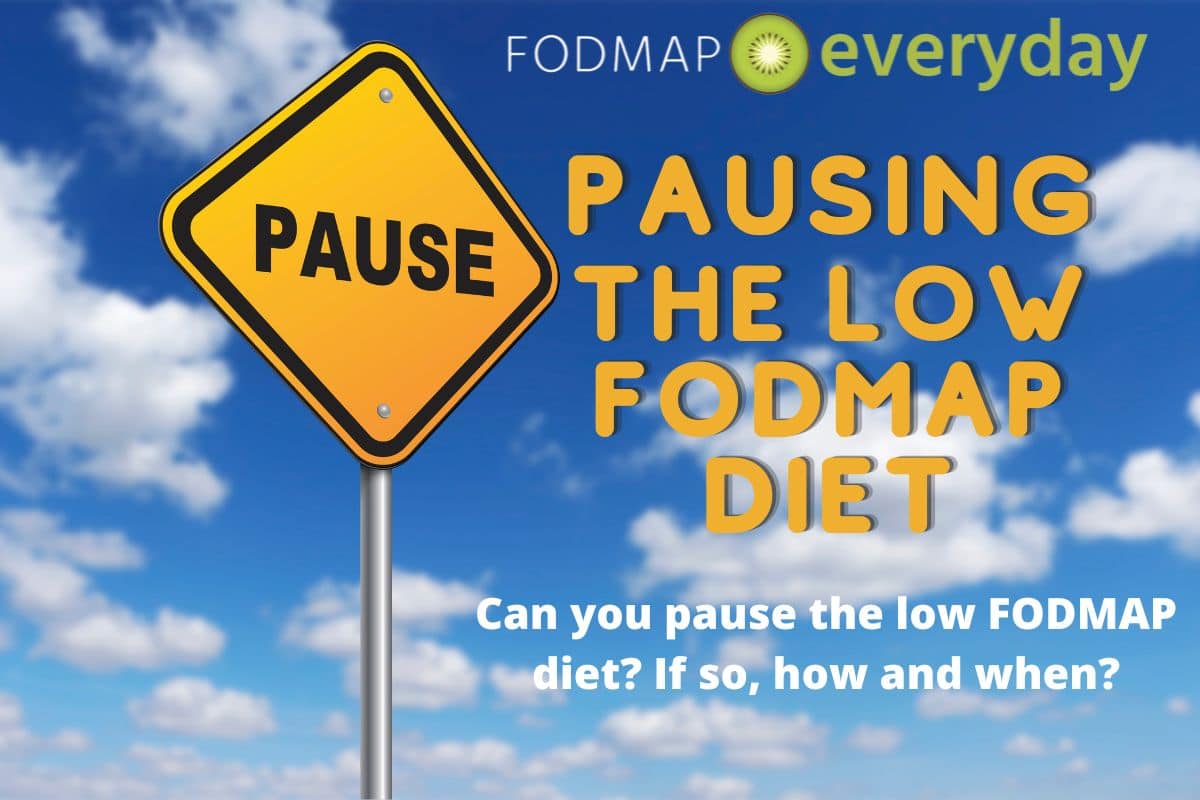
Look At Your Life Schedule
Before recommending a low FODMAP diet to my patients, I always ask about their upcoming schedule — any weddings, travel, work events, or fancy dinners in the near future? I’m not looking to score an invitation; rather, I’m trying to determine if it’s the right time to begin a restrictive diet, especially one that removes everyday foods, like garlic and onion.
There’s no doubt a low FODMAP diet can improve gastrointestinal (GI) symptoms in many with irritable bowel syndrome (IBS), but timing is everything. If you’re flying off to Italy next week to feast on garlicky goodness, I suggest you delay starting the low FODMAP diet.
But what if you’re already on a low FODMAP diet? You might wonder if it’s OK to hit the brakes.
The answer is yes. It’s OK to take a break from the low FODMAP diet no matter what phase you’re in.
A low FODMAP diet is for symptom management and symptom management only. It’s not a cure for IBS, small intestinal bacterial overgrowth (SIBO), inflammatory bowel disease (IBD) or any other health condition. Eating high FODMAP foods might worsen how you feel, but these foods did not cause your condition, nor will avoiding them cure it.
I’ve worked with many patients who feel terrific on a strict low FODMAP diet but cringe at the idea of adding back FODMAPs — “what if I undo all my hard work?” they ask.
Remember, there are three phases of a low FODMAP diet:
- The Elimination Phase
- The Challenge Phase (called Reintroduction By Monash University)
- The Integration Phase (called Personalization by Monash University)
Just as you can safely advance through these phases, you can safely pause the diet any time.
It’s worth noting why we at FODMAP Everyday® call the Phases what we do. During the second phase, you are “challenging” yourself with foods to determine your FODMAP reaction. There might be a food you don’t digest well at this point in time. It’s always suggested that at a later point, maybe 6 months or more after you have completed your Challenge Phase, you try again. BTW, your GI tract is not static, and you might very well find out that you can tolerate a food you didn’t before. This is just one very important reason to reintroduce foods.
We call the third phase “Integration” because you will integrate all the information you have gained in the first 2 phases to create your longer term dietary approach. When you hear the low FODMAP diet is not a forever diet, that comment is really addressing the initial Elimination Phase. Your Integration phase can be longer term, as you will have added FODMAPs back into your diet, improving the health of your microbiome.
Timing Is Everything
One of the best parts of a successful low FODMAP diet is it improves quality of life… when the timing is right. You might not feel this way if you’re trying to follow a low FODMAP diet while dining out at a 5-star restaurant or backpacking through Europe.
It’s important that you consider your ability to undertake the Elimination and Challenge Phases of the diet when you have the most uninterrupted time span to do so. That being said…
What If I Have To Pause the Diet? And Other FAQs
Now, before we move on to practical tips for how best to pause the low FODMAP diet, let’s address some common questions I hear from patients:
That depends. How long do you plan on pausing the diet? If you’re talking about stopping for a few weeks because you’re heading on vacation or studying for finals, then most likely you can pick up where you left off. But, if it’s going to be a while (let’s say a month or more), then you might start over.
As Monash tests more foods for their FODMAP content, it’s possible the diet itself will change and/or your response to the diet might change. It’s possible the diet itself or your response to the diet will change. And if you weren’t working with a GI dietitian, make sure to do so the second time around. The low FODMAP diet is much more effective when carried out under the guidance of a knowledgeable dietitian.
During the Challenge phase, I work closely with my patients to personalize food challenges — either by one FODMAP group or food at a time. We strategically plan what to reintroduce based on their past medical history, current symptoms, food preferences, and food tolerances. By taking a well thought out approach, we’re maximizing their chances of success and setting ourselves up to learn information to navigate the Challenge and Integration phases.
However, there is nothing to fear by randomly adding back FODMAPs as you’ll likely do if you pause the diet. You’re just less apt to identify food tolerances or triggers.
For example, let’s say you pause the Challenge Phase for your town’s annual chili contest… you eat a bowl of chili with garlic, onions, black beans, pasta and a side of cornbread. You haven’t officially challenged any of these foods, and now you feel a huge uptick in your IBS symptoms. (BTW, everyone should expect some gas or other symptoms after eating a bowl of bean chili — that’s normal since many of our healthy gut microbes love to feast on beans and, in turn, produce gas). Because you added so many foods at once, you won’t know if your symptoms are because of a particular food or foods, a cumulative effect or both.
Once the FODMAPs are out of your system, give or take 12-72 hours, you should feel normal. So, return to the low FODMAP diet, wait at least three days, and then resume the Challenge Phase. No harm done.
By now, your regular diet should include some high FODMAP foods. Eating ones you don’t tolerate or more than your body can handle might worsen IBS symptoms but not lead to lasting problems. Again, once the FODMAPs are out of your system, you should go back to feeling your “normal”. That said, no one enjoys feeling sick.
That’s why in this article we share lots of tips to help you better tolerate adding more FODMAPs to your diet.
Take note! Regardless of what phase you’re in, pausing the diet will not hurt you, nor will it destroy your progress.
The Middle Ground: Be FODMAP Conscious
Maybe you don’t want or need to quit cold turkey, meaning you could pause in a way that is more flexible and lenient. Perhaps there’s an opportunity to continue to follow aspects of the diet without it interfering with your quality of life.
If so, instead of just ceasing your progression through Elimination or Challenge Phases, you might transition to a FODMAP-Gentle diet, which effectively reduces IBS symptoms without restricting as many foods as the whole shebang. On this approach, you avoid the following high FODMAP foods: wheat, rye, onion, leek, garlic, cauliflower, mushrooms, apple, pear, dried fruit, stone fruit, watermelon, milk, yogurt and legumes.
You might choose to avoid or limit all these foods, some of these foods, or just use this list as a guide for avoiding FODMAP overload. Maybe you’ll have an apple with lunch, but choose broccoli over cauliflower at dinner.
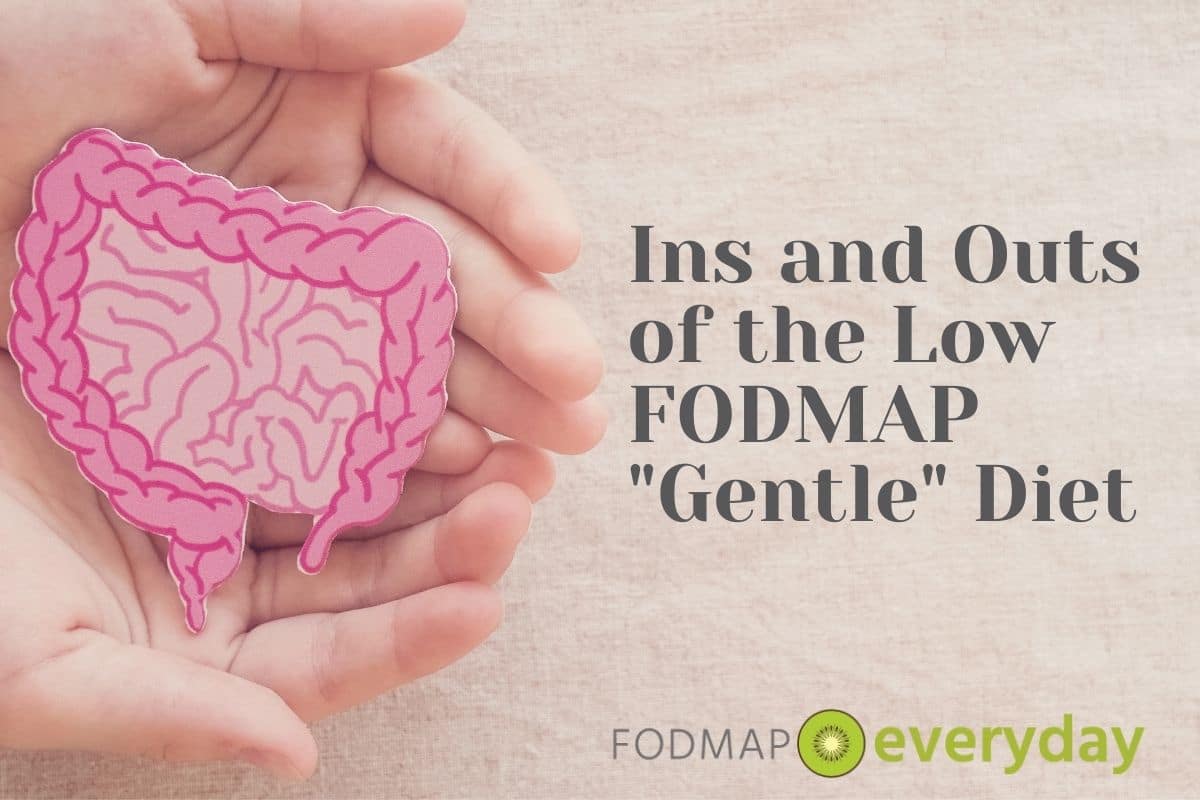
You may want to read: Ins & Outs of the Low FODMAP “Gentle” Diet
Tips For Limiting/Pausing FODMAPs In The Diet
Besides following a FODMAP-gentle diet, here are some other tips to help you easily limit – or pause – your intake of FODMAPs:
- Order sauces on the side. Many sauces are full of FODMAPs. Dipping food versus smothering it will let you enjoy the taste of the sauce without eating as many FODMAPs.
- Pack your own healthy snacks. Lots of popular on-the-go snacks, especially snack bars, contain hidden sources of FODMAPs.
- Test some foods before you break. Maybe you don’t have time for a formal FODMAP Challenge, but you’d like to prepare to eat these foods soon. For example, if you’re planning a trip to the Mediterranean, you might try some yogurt or wheat before you go.
- Side note: Lots of my IBS patients who can’t tolerate wheat and dairy in the U.S. often feel fine eating it when they’re overseas. We think this has to do with a combination of factors: less stress on vacation, different agricultural practices, rapid changes in your gut microbiome, and overall changes in your diet.
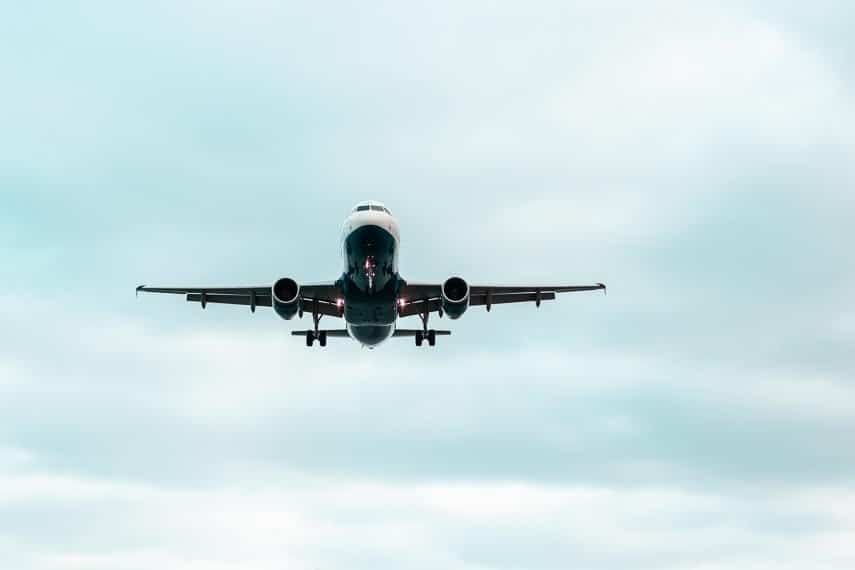
Traveling with IBS Series
Don’t let your gut health get in the way of enjoying what the world has to offer! Our series Traveling with IBS covers general travel tips as well as individual country guides to happy belly adventures!
Beware of Other Food Triggers & Food Helpers
FODMAPs are just one group of foods that can trigger IBS symptoms. There are plenty of other common IBS triggers to look out for – and you might want to pause eating these as well.
Some of the most common offenders include:
- Alcohol, including beer, wine and liquor
- Coffee, both decaf and caffeinated
- Greasy foods, especially fried foods or oily foods
- Foods high in insoluble fiber (i.e. roughage), such as popcorn, whole nuts and seeds, kale salads
- Artificial sweeteners, like aspartame, saccharin and sucralose
- Sugary drinks, including soda, nutritional shakes, sports drinks, sweetened iced teas and lemonade
- Spicy foods, like red pepper flakes and hot sauce
- High-histamine foods, such as aged cheeses, cured meats and wine
By limiting or avoiding these foods, you might have better control over how you feel.
Consider…
- Choosing baked foods over fried foods
- Limiting alcohol to one drink, if any at all.
- Opting for hot tea over coffee.
- Limiting roughage by choosing cooked vegetables over raw vegetables. Bonus: Cooked foods are less likely to harbor food-borne pathogens.
- Hydrate with water. For added flavor, choose fruit-infused water (like strawberry & mint or ginger and lemon) or add a splash of juice.
- Ditch the artificial sweeteners. Instead, choose a tad of real sugar or maple syrup.
- Use non-spicy spices and herbs to flavor your dishes. Bonus: Besides conventional garlic and onion powder, herbs and spices are low FODMAP.
- Steer clear of the charcuterie board.
Some Foods Help IBS!
Here’s some good news! Some foods help IBS. For example, foods rich in soluble fiber, such as oats and chia seeds, can work wonders for producing normal and fully evacuated bowel movements. And two green kiwifruit can ease constipation in people with IBS-C. I’ve received lots of GIFS of dancing kiwis from appreciative patients. Whether you are pausing or not, reading up on fiber will be helpful
Please read our article: Fiber & IBS: What You Need To Know
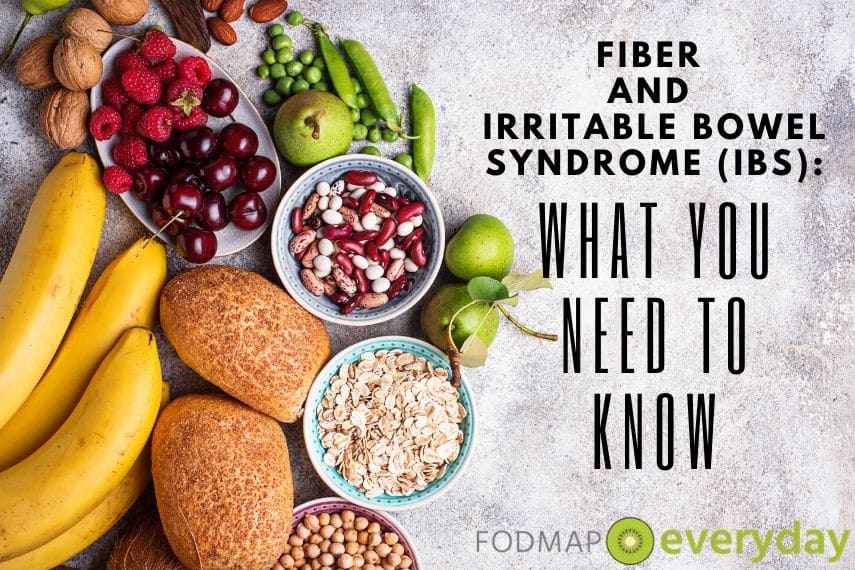
You may want to read: Fiber & IBS: What You Need To Know
Consider Non-Food Triggers
Most people with IBS associate one or more foods as triggers for their IBS symptoms, but there are some key non-food factors to consider, too. Fortunately, for every trigger, there’s a counter-trigger.
If you are pausing the low FODMAP diet, it bears to keep these triggers and management strategies in mind…
Large portions. Eating too much at one time can worsen abdominal pain, bloating, gas, constipation and diarrhea—all common IBS symptoms. Plus, FODMAPs have a loading effect, so larger portions will probably contain more FODMAPs. Many with IBS benefit from eating smaller portions more frequently throughout the day, with one caveat… larger portions can prompt peristalsis and create an urge to poop, which can help those with IBS-C. We evolved to poop in the AM, so consider making breakfast your largest meal.
Eating too quickly. I’ve worked with patients who admit to choking on their food because they eat too fast. If you’re a fast eater, you’re probably going to feel lousy after eating anything, low FODMAP or not. Slow down, chew your food well. Try eating with your non-dominant hand or taking a few breaths in between bites.
Chronic stress. Contrary to popular belief, stress doesn’t cause IBS. However, it can worsen IBS symptoms. Remember, IBS is a disorder of the gut-brain interaction, so stress management is an incredibly important part of IBS treatment. Did you know that research has shown gut-directed hypnotherapy to be as effective as the low FODMAP diet for managing IBS symptoms? Pretty neat!
Emergency Checklist
I’m fond of telling my patients how three things can happen when they begin a new intervention, dietary or otherwise:
- They’ll feel better
- They’ll feel the same
- They’ll feel worse
Obviously, my goal is that they’ll feel better, and worse case, they’ll feel the same. But there are times they’ll feel worse. Even with the best preparation, you might feel an uptick in symptoms when you pause the low FODMAP diet. That’s normal and okay.
Fortunately, there are some things you can try to help prevent and/or ease symptoms when you come off the low FODMAP diet…
Digestive enzymes
Taking a digestive enzyme, such as lactase when you eat lactose-containing foods, can ease food-induced symptoms.
Enteric-coated peppermint oil
Peppermint is a gentle anti-spasmodic that can ease IBS symptoms, particularly abdominal pain, cramping and gas. Choose enteric-coated to reduce risk of heartburn.
Soluble fiber supplement
Fiber supplementation can help promote bowel regularity. I’m a big fan of psyllium seed husk powder because it can help with constipation and diarrhea. Plus, it’s not very fermentable, so it’s less likely to cause gas compared to other supplements.
Baggy clothes
Be sure to have a maxi dress, muumuu or flowy t-shirt nearby. You’ll feel better physically and mentally.
Hot water bottle or heating pad
Heat can soothe physical and psychological pain. Lie down and place a hot water bottle or heating pad directly on your abdomen.
The Takeaway
The low FODMAP diet is a safe and effective way to manage IBS symptoms, but timing is everything. Know that it’s perfectly OK to pause the low FODMAP diet, and sometimes it’s for the best. Use this information to transition as seamlessly as possible, no matter what phase you’re in, and let us know how it goes by leaving a comment below!
